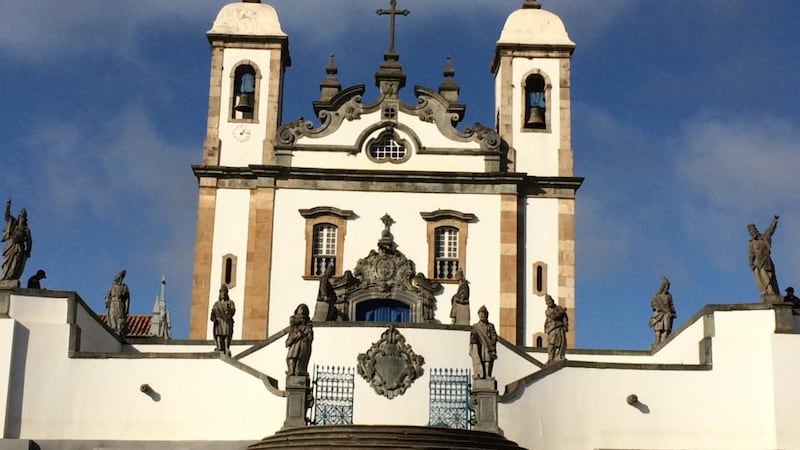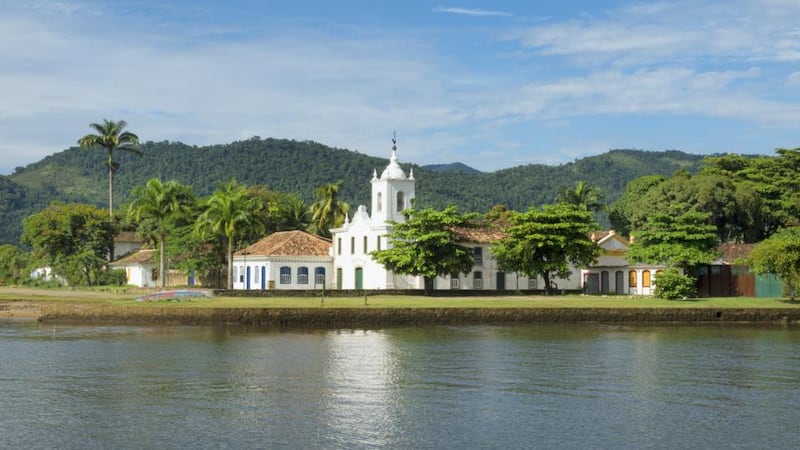Step into the Pousada Ana Doce, a guest house in the Brazilian city of Sao Sebastião , and you step into a cool, laid-back world of sub-tropical enchantment. Inviting French doors on the pretty, single storey stucco building peer on to the street and, walking inside, one is transported immediately to another place, a place of luxuriant tropical plants and flowers; of pastel painted walls and doors in lilac, pink and canary yellow.
The entrance floor of the Ana Doce is made of highly-polished dark wood and there are little nooks and crannies everywhere, with sofas and low tables. Indigenous artefacts are dotted about.
Boisterous plants are everywhere – palms and ferns of course, some in small beds, others in pots. There’s a pink bougainvillea in flower and a rude red hibiscus brightening this little jungle world of glossy green leaves and variegated fronds.


It's a fair bet that few, if any, World Cup fans will see the inside of the Ana Doce. A shame really, as no doubt this delightful San Sebastian pousade (the Brazilian word for independent B&B, guest house or boutique hotel) could do with some off-season business; and any fans staying there would experience a side of Brazilian life and culture as different from football as, well, the style of the game played here as compared to some other places.
I came across the Ana Doce late last month while exploring a little of Brazil with Belfast motorbike and travel writer Geoff Hill. Our journey began in Rio de Janeiro when Nicolay Figueroa of Rio Triumph lent us a bike each, a Tiger Explorer 1200 for Geoff and a Tiger 800 for me, and off we went.
The Costa Verde is around 300kms of coastline south and west of Rio, stretching all the way to Santos, a major port that serves the needs of Sao Paulo, a little further inland, and the 30 million or so people who live in that city and its hinterland.
And what a highway, what a coastline.
The road weaves its way through a blanket of jungle that tumbles down the slopes of the Serra do Mar coastal range. There are tropical ferns seven metres tall and clumps of giant bamboo reach up for perhaps 50 metres before draping their stems over the road. The coast is very irregular, peninsulas sticking out into the sea alternating with fingers of ocean protruding into the landscape so that vistas of green are replaced, turn by turn, by panoramas of turquoise sea, islands and beaches.
The road is broad and well maintained for the most part. The sort of long, sweeping curves that bikers love just keep coming and by the time we stop for our first night, at the old colonial seaside town of Paraty, we are exhilarated. Paraty itself raises spirits further.
The town emerged in the late 17th century as the gold exporting port for Portuguese colonialists and has changed little since (apart from an absence of gold). Terraces of whitewashed, single or two-storey buildings line a grid pattern of cobbled streets where shops, bars and restaurants cater for tourists and residents alike.
The Eclipse is our first pousada. It’s an attractive stucco and stone house, with a pool, on the edge of town, where twin bed room and breakfast comes in at €25 a head. (The Ana Doce was about €35.)
The Eclipse breakfast is a typical Brazilian mix: scrambled eggs and sausage and pepper stew; various types of melon, cereals and yoghurt, bread and sweet cakes, including two types of tapioca cake, coffee and fresh orange juice.
Despite some pre-trip warnings, the food we experienced throughout our trip was excellent and, as often as not, we ate in the sort of roadside restaurants frequented by truck drivers. Our first was in Seropedica, a deadbeat ribbon of garages, workshops and discount outlets lining a road somewhere north-west of Rio, where we landed after an early malfunction of the Hill-Nav sent us more or less precisely in the opposite direction to the one sought.
Never mind, it delivered us into the arms, metaphorically, of Adriana and Ivanete who, along with Gildo, run the Folha Dourada, a roadside transport eatery. For about €4.50 each and beneath an incongruous biscuit-tin-style picture of an English Tudor cottage, we ate our fill from their buffet of lettuce, chopped white cabbage, onion, cucumber, beetroot and tomato, plus rice with chicken, pork, sausage stew and beans – all of it delicious and all served with post-meal directions that far exceeded Mr Hill’s navigational acumen.
When Brazil’s roads are good, they’re very good. And for the most part, they are good. But the astonishing volume of truck traffic (including trailer trucks with nine axles and 34 wheels hurtling at speed to cover vast distances between cities in what is the fifth largest country in the world) churns them up and makes biking, or any sort of motoring, well, interesting in a sort of nerve-jangling but exciting way.
The traffic in São Paulo defeated us. A multi-lane highway into the city was jammed as far as the eye could see. The only relief came from spotting a family of capybara, the wild, South American guinea pig-like rodents the size of cocker spaniels. They munched grass happily on wasteland under a flyover as drivers choked in traffic, barely inched forward while reckless bikers hurtled along between the lanes of cars and lorries.
We turned tail and headed for Brasilia, 1,000kms and two days hard riding away.
The journey there, and back south again via Belo Horizonte, crossed sugarcane plantations the size of Munster (grown for ethanol and for distilling cachaça, Brazilian rum); maize and other oil-seed crops on a similar scale, and cattle ranches. There were regular sightings of parrots, some Blue and Yellow Macaws, large birds with long tail feathers; and smaller green parrots, darting through the air and squabbling incessantly.
In the forest on the banks of the Rio Abaeté as I watched a family play and catch catfish. Flashes of electric blue lit up the forest from butterflies flitting to and fro, and a toucan glided past – magical, like the zoo come to life.
From the savanna grasslands surrounding Brasilia, the landscape south of Belo Horizonte becomes mountainous once again and perched between several steep slopes is Ouro Preto, a town of some 70,000 people and the regional capital until 1897. The place is littered with baroque churches, many of which display sculptures by the town’s most famous son, Antonio Francisco Lisboa, otherwise known as Aleijadinho.
But the churches are closed on Monday and so we press on 60 kilometres to Congonhas to view his masterpiece, the Basilica do Senhor Bom Jesus de Matsinhos and its six small, oddly Islamic-looking chapels on the slope leading up to the church.
The basilica, built between 1757 and 1790, is heavily baroque inside and festooned with paintings and a theatrically over-the-top retablo with Christ crucified on high, and below the altar, lying also in a glass-fronted sarcophagus, head resting on a white silk pillow, eyes wide open staring upwards.
Outside, 12 statues of prophets sculpted by Aleijadinho stand like sentinels, looking down at the passion chapels, filled in turn by 64 cedarwood carvings telling the story of the crucifixion and resurrection.
But most astonishing of all is that Aleijadinho, who had contracted leprosy, his withered fingers deformed and useless, is reputed to have carved using chisels strapped to the stumps of his hands.
Our beds for the night are in the Hotel Colonial, a relic of faded decency that a lick of paint and a string quartet would revive.
The road down to Rio is uneventful, save for the heavy rain and spattering of deep red mud sprayed all over us by the trucks. At dawn, we take a final look at Rio’s unmatched setting by cruising the bikes along the seafront at fashionable Flamengo, against a backdrop of the Sugarloaf Mountain.
The buildings and their chi-chi apartments could be on Park Lane in London. The setting oozes wealth.
As we pass a traffic island heading back to Copacabana, a man is dismantling his home for the night, a sheet of black plastic held up by his bicycle leaning against a palm tree and covering the cardboard on which he will spend the night.
The route, the bikes, the flights
Travel writer Geoff Hill and I rode 2,800km kilometres over nine days. Our full route was Rio de Janeiro, Paraty, Sao Sebastiao, Sao Paulo, Brasilia, Paracatu, Belo Horizonte, Ouro Preto, Congonhas, Rio.
I rode a Triumph Tiger 800 for most of the journey. It was easy to handle, responsive, not too heavy and performed flawlessly. A tough bike, well up to adventure biking, it would be even better with a larger, more protective windscreen.
Geoff rode the Explorer 1200, a more powerful (though not by much) and bulkier machine, with panniers and a topbox. The Explorer is a direct competitor to the king of adventure biking, the BMW R1200 GSA. When performing, the Explorer displayed solid power and handled well. Unfortunately, however, either impure Brazilian petrol (a constant hazard) or perhaps a circuit board flaw kept prompting the engine management system to shut down. Happily, it sprang to life again each time after resting for a few minutes.
While Triumph, which has an assembly plant in Manaus, Amazonia, supplied our bikes, we travelled independently. There are several companies that offer all-in, motorcycle tours of Brazil. They include compassexpeditions.com which offers 14 days with BMW F700GSs for €4,500; rideavd.com offers much the same, covering most of our route, for €4,600; while brazilmoto.com offers tours of up to two weeks, on a variety of bikes, including the BMW F650GS, R1200GS and Honda Varadero XL 1000 Vs, €2,400 to €6,000.
Getting there
There are no direct flights between Dublin and Rio de Janeiro. Peter Murtagh travelled British Airways, Dublin-London-Rio return for €786. Other airlines, including Air France, Lufthansa, Iberia, KLM and some US airlines, also fly indirect and, depending on how long you are prepared to hang around in transfer airports, costs can be as low as €659.




















